By Donald-Brian Johnson
“Here comes Santa Claus,
Here comes Santa Claus,
Right down Santa Claus lane!”
– Gene Autry & Oakley Haldeman, 1947
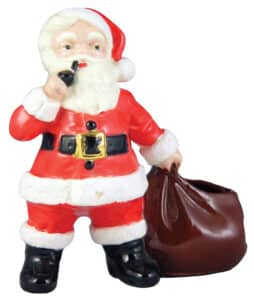
Santa. St. Nick. Father Christmas. No matter what they call him in your neck of the woods, it’s Christmas time again, and … he’s baaaack!
Although the custom of Christmas gift-giving originates with the Three Kings, the legend of Santa Claus dates to the fourth century. Stories of his origin vary, but here’s one favorite:
The setting was Asia Minor, where a down-on-his-luck nobleman found himself unable to cough up dowries for his three daughters. Enter St. Nicholas, a kindly (and well-to-do) bishop, who crept to the man’s home one wintry eve. With exceptionally good aim, he tossed the three bags of gold he’d brought along through an open window. They conveniently landed in three stockings left hanging to dry before a roaring fire. The result: dowries for each daughter. Thanks to some sleuthing on the part of the happy nobleman, his mysterious benefactor was identified, and tales of the generosity of St. Nicholas soon became legend.
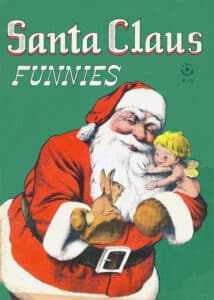
Early helpers of St. Nicholas (i.e., parents), stayed with the stuffed-stocking theme, although bags of gold were quickly replaced by apples, oranges, candies, and small homemade toys. Other cultures offered their own variations. Children who lived in The Netherlands filled wooden shoes with hay for the horses accompanying “Sinter Klaas” (that’s Dutch for “St. Nicholas”). The next morning, delightful goodies had miraculously taken the place of the hay. Italian children waited until January 6th, the “Feast of the Three Kings,” for the arrival of “La Befana,” who filled their empty shoes with treats. For Puerto Rican boys and girls, the Epiphany was also eagerly anticipated. Tiny boxes filled with munchies for the Wise Men’s camels—leaves and other vegetation—were replaced by morning with the sort of munchies human children enjoy.
St. Nicholas made his way to America with Dutch immigrants in the 1600s. Mispronunciations of “Sinter Klaas” by those unfamiliar with the language eventually resulted in the name we now know and love: “Santa Claus!”
“A Little Old Driver, So Lively And Quick”
Initial depictions of Santa offer us a thin man with a long, scraggly white beard, clad in what appears to be a hooded, floor-length red bathrobe.
Even Clement Clarke Moore’s 1822 poem, A Visit from St. Nicholas, which cemented in the popular consciousness such images as “stockings hung by the chimney with care,” “eight tiny reindeer,” and unannounced entrances via a chimney, referred to Santa as a “right jolly old elf.” Early illustrations accompanying Moore’s poem accented Santa’s gnomish, elf-like appearance. (Moore is said to have based the characterization on his right jolly old handyman, Jay Duyckinck.)
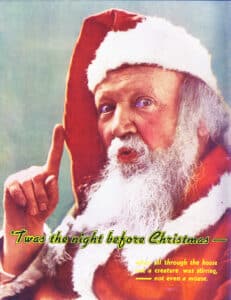
The image of a roly-poly, human-sized gent in a red suit and fluffy white beard, came courtesy of Harper’s Bazaar illustrator Thomas Nast, in the 1860s. That visual, refined since then in countless Coca-Cola ads by Haddon Sundblom, and Ideals magazine covers by George Hinke, are essentially the “Santa” we recognize today.
Stores jumped on Santa’s sleigh as early as the 1820s. In 1841, a life-size Santa figure in a Philadelphia shop window attracted hordes of eager youngsters, who dragged along their toy-buying parents, much to the owner’s delight. Live department store Santas soon followed, as did “Letters to Santa,” those annual wish lists which turned such tiny towns as “Santa Claus, Indiana” into postal Meccas.
Over the centuries, Santa Claus has at times been denounced. A Danish clergyman referred to him as “en hedensk trold” (that’s “a heathen goblin”), and even his very existence has (gasp) occasionally been denied. Francis Pharcellus Church set the record straight, in an 1897 New York Sun editorial. Eight-year-old Virginia O’Hanlon had sent in a letter asking if Santa Claus was real, as her little friends had told her differently. Church responded:
“Yes Virginia, there is a Santa Claus. He exists as certainly as love and generosity and devotion exist … No Santa Claus! Thank God he lives, and he lives forever! A thousand years from now, Virginia, nay, ten times ten thousand years from now, he will continue to make glad the heart of childhood.”
“A Holly Jolly Christmas”
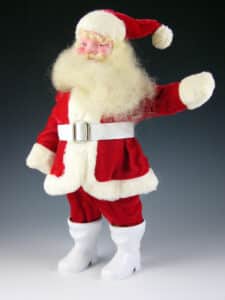
Santa Claus has had a long, long, really long life. That means, for Santa sleuths, there’s plenty of Claus-related trivia to memorize and spring on unsuspecting guests at your next holiday get-together:
• If the feast of St. Nicholas is December 6th, when did Santa start giving out goodies on Christmas? Well, when Henry VIII formed the Church of England in the 16th century, December 6th was no longer a religious holiday. So, Santa was on the move to the next logical date.
• In the Swiss-German region of Switzerland, no elves accompany Santa Claus (“Samichlaus”) on his rounds. Instead, it is “Schmutzli,” who is on the lookout for misbehaving children to swat with her broom.
• In the United States, Santa settles for a Christmas Eve treat of cookies and milk. He’s somewhat luckier in Great Britain and Australia, where the treats include sherry and beer.
• Santa Claus won an Oscar! Well, actually it was Edmund Gwenn, who played “Kris Kringle” in the 1947 movie classic, Miracle on 34th Street.
• Miracle was set at Macy’s Department Store in New York City, and Santa has been a star of Macy’s Thanksgiving Day Parade since the very first one in 1924. Visiting Santa at Macy’s is a time-honored tradition, and kids of all ages are welcome. (I speak from experience).
• The “NORAD Tracks Santa” Christmas Eve program began as a happy accident. A 1955 Sears Roebuck ad in Colorado Springs misprinted its “Santa Hotline” number. Calls instead reached the Continental Air Defense Command. In the spirit of the season, Director of Operations Col. Harry Shoup told young callers that radar indicated Santa was on his way from the North Pole – and a tradition was born.
• Around the world, Santa has plenty of helpers. The largest-ever squad of “Santas” gathered in India on December 27, 2014, to ho-ho-ho in the holidays.
“All Is Merry And Bright”
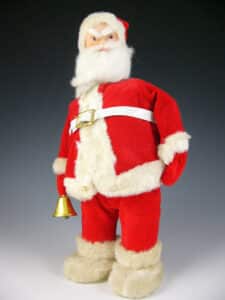
light-up eyes, 13-1/2” h.
For collectors of Santa memorabilia, there’s a boundless treasure trove to choose from. There are Santa figurines. Santa bubble lights. Plastic wall Santas. Some Santas even talk: push the button, and a merry voice booms out “Ho, ho, ho! I’m Santa!” (As if introductions were really needed.)
And it’s not just Santa. Joining him is an entire sleighful of North Pole denizens: Mrs. Santa, the elves, the reindeer (with Rudolph lighting the way), choruses of carolers, and an avalanche of snowmen, making the seasonal circle complete. Who knew there could be so many variations on a theme? Santa & Co. have been featured on holiday candy dishes, ashtrays, tea towels, drinking glasses, mugs, cookie plates, tidbit trays, salt-and-peppers, and candle holders.
Source materials for Santas have run the gamut, from glass and plastic to wood and metal. Over the decades, homemaking magazines have encouraged the especially crafty to rummage through whatever was at hand for homemade artistic inspiration, resulting in a merry multitude of construction paper Santas with cotton ball whiskers.
Most popular with collectors, however, are vintage Santa representations from the 1950s and ‘60s. Of these, the most prevalent (and durable) are Santas fashioned from ceramic. Thanks to the introduction of airbrush painting just after World War II, Santa features could now be more delicately and smoothly styled. Goodbye to flat-faced stares and clown-like red cheeks. Other attributes adding to the desirability of postwar ceramic Santas:
Metallic accents. Where would Ol’ St. Nick be without his gold belt buckle? After a ceramic was painted and fired, metallic accents were often hand-applied. The piece was then fired again at a lower heat. A touch of gold gave Santa’s red and white outfit visual pop.
On some pieces, the gold highlights were sponged on, creating an attractive stippled effect.
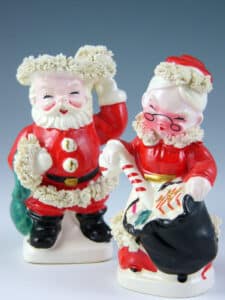
salt-and-peppers. Japan, 4” h
Spaghetti art. A ceramic Santa gained texture and dimensionality through the application of thin, entwined clay strands, visually amplifying everything from his beard to the ermine-like trim on his red costume. Since the clay “spaghetti” was applied by hand, even mass-produced Santas possessed a certain individuality. As for the name? The clay pieces certainly looked like spaghetti, and the machine that extruded them was remarkably similar to a spaghetti press.

Flocking. Applied flocking gave ceramics the appearance of lush velvet at a fraction of the cost. The secret ingredient: glue. Portions of the ceramic to be flocked were glue-coated. “Flocking” (polyester fiber bits) was then sprinkled on, adhering to the glue. Many ceramic Santas were no doubt grateful for this addition of eye-catching elegance.
For Santa collectors, here’s good news: a bottomless treasure trove awaits! A quick check online brings up hundreds of listings for Santa-themed items, leading to one basic conclusion: no matter how many Santas you collect, you’ll never run out of options.
Vintage Santas remain extremely affordable – almost all under $50, primarily because they were produced in such vast quantities. After the restrictions of World War II were eased, decorative Christmas items by such importers as Lefton, Napco, and Enesco flooded the market.
Cheap but charming, these imports brightened many an American home. Today, like individual sparkling snowflakes, they recapture—at least for a moment—the nostalgic appeal of a more innocent era.
Time to start making that list (and checking it twice).
And remember:
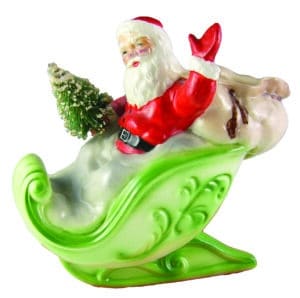
“He sees you when you’re sleeping,
He knows when you’re awake;
He knows if you’ve been bad or good—
So be good, for goodness sake!”
– J. Fred Coots & Haven Gillespie, 1934
That’s right –
Donald-Brian Johnson is the co-author of numerous books on design and collectibles, including Postwar Pop, a collection of his columns. Please address inquiries (or invites for cookies and milk) to: donaldbrian@msn.com
Photo Associate: Hank Kuhlmann





Related posts: